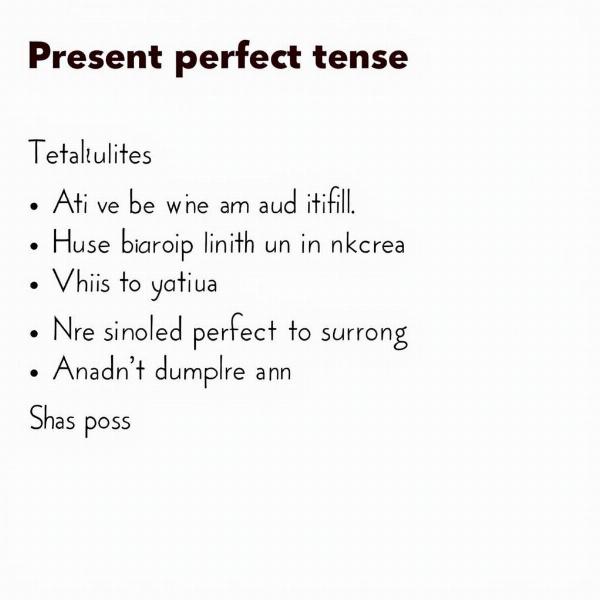Understanding the present perfect tense is crucial for anyone learning Hindi. It connects the past to the present, expressing actions that have occurred at an unspecified time before now or actions that began in the past and continue to the present. This guide will delve into the meaning, formation, and usage of the present perfect tense in Hindi, providing you with the knowledge you need to communicate effectively.
Formation of the Present Perfect Tense in Hindi
The present perfect tense in Hindi is formed using the auxiliary verb “है” (hai – is/am/are) or its variations based on gender and number, combined with the past participle of the main verb. The past participle is typically formed by adding -आ (aa), -या (yaa), or -ई (ee) to the verb stem. Let’s explore the structure:
- Subject + Past Participle + है (hai) / हो (ho) / हैं (hain)
For example:
- मैं खाया है (Main khaaya hai) – I have eaten.
- तुम पढ़े हो (Tum padhe ho) – You have read (masculine singular informal).
- आप पढ़े हैं (Aap padhe hain) – You have read (formal/plural).
- वह गई है (Vah gai hai) – She has gone.
- वे गए हैं (Ve gaye hain) – They (masculine/mixed gender) have gone.
Common Uses of the Present Perfect Tense
The present perfect tense has several key applications in Hindi conversation:
- Completed Actions with Present Relevance: This tense emphasizes the present relevance of a past action. For instance, “मैं खाया है” (Main khaaya hai) implies not just that I ate, but that I am no longer hungry or that the food is finished.
- Indefinite Past Actions: When the specific time of an action is unimportant, the present perfect tense comes into play. Saying “वह भारत गया है” (Vah Bharat gaya hai) simply means he has been to India at some point, without specifying when.
- Actions Continuing from the Past to the Present: For actions that started in the past and are still ongoing, we use the present perfect. For example, “मैं दो साल से यहाँ रह रहा हूँ” (Main do saal se yahan rah raha hun) translates to “I have been living here for two years.”
 Present Perfect Tense Examples in Hindi
Present Perfect Tense Examples in Hindi
Differentiating Present Perfect from Other Tenses
It’s important to distinguish the present perfect from similar tenses:
- Simple Past: While both tenses refer to past actions, the simple past emphasizes the completion of the action in the past, whereas the present perfect emphasizes its connection to the present.
- Present Continuous: This tense describes actions happening at the moment of speaking, while the present perfect focuses on actions completed at an unspecified time before now.
Mastering the Nuances of the Present Perfect
Certain nuances can influence the use of the present perfect tense:
- Emphasis on Completion: The emphasis on the completion of an action can be strengthened by adding words like “अभी” (abhi – just) or “चुका” (chuka – already).
- Duration of Action: To specify the duration of an action continuing from the past to the present, we use words like “से” (se – since) or “तक” (tak – until/for).
Practical Examples and Conversations
Let’s illustrate the present perfect tense with some real-life scenarios:
-
A: क्या आपने खाना खा लिया है? (Kya aapne khana kha liya hai?) – Have you eaten?
-
B: जी हाँ, मैं खा चुका हूँ। (Ji haan, main kha chuka hun.) – Yes, I have eaten.
-
A: कब से आप हिंदी सीख रहे हैं? (Kab se aap Hindi seekh rahe hain?) – Since when have you been learning Hindi?
-
B: मैं दो महीने से हिंदी सीख रहा हूँ। (Main do mahine se Hindi seekh raha hun.) – I have been learning Hindi for two months.
Conclusion
The present perfect tense, while seemingly simple, is essential for fluent Hindi communication. By grasping its formation, usage, and subtle nuances, you can express yourself accurately and confidently. Understanding this tense will not only enhance your grammatical skills but also deepen your understanding of the Hindi language. Remember to practice using the present perfect tense in various contexts to truly master it.
FAQ:
- What is the difference between “मैंने खाया” (maine khaya) and “मैं खाया है” (main khaaya hai)? The former is simple past, focusing on the past action. The latter is present perfect, connecting the past action to the present.
- Can the present perfect tense be used with future time expressions? No, it’s used for actions completed before now, not in the future.
- How do I negate the present perfect tense? Add “नहीं” (nahin – not) after the past participle: “मैं नहीं गया हूँ” (Main nahin gaya hun) – I haven’t gone.
- What are some common mistakes to avoid with the present perfect? Confusing it with the simple past and not using the correct auxiliary verb form based on gender and number.
- What are some other ways to express the present perfect meaning in Hindi? You can use “अभी-अभी” (abhi-abhi – just now) with the simple past for a similar effect.
- How can I improve my understanding of the present perfect tense? Practice regularly with various examples and conversations.
- Where can I find more resources to learn about Hindi tenses? There are many online resources and textbooks dedicated to Hindi grammar.
Meaning-Hindi.in is your one-stop solution for all your Hindi translation needs. We specialize in various translation services, including Business & Commercial Document Translation, Certified & Legal Document Translation, Technical & User Manual Translation, Website & Localization Translation, Educational & Academic Document Translation, Express Translation, and Specialized Translation. Our team of expert Hindi linguists ensures accurate and culturally sensitive translations, tailored to your specific requirements. Contact us today for a free quote! Email: [email protected], Phone: +91 11-4502-7584. Meaning-Hindi.in is committed to delivering high-quality Hindi translations to bridge the communication gap between languages and cultures.